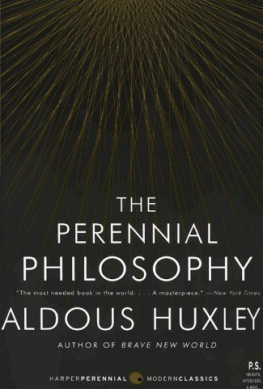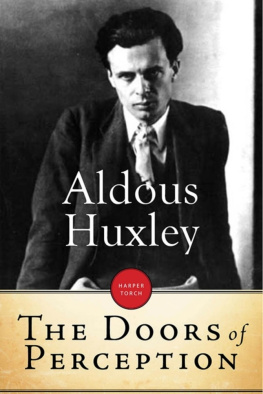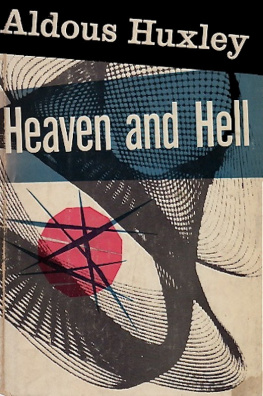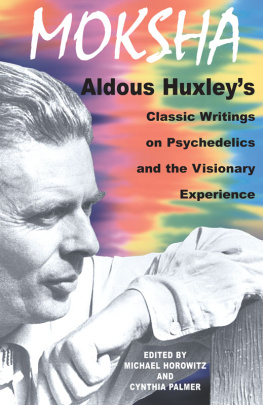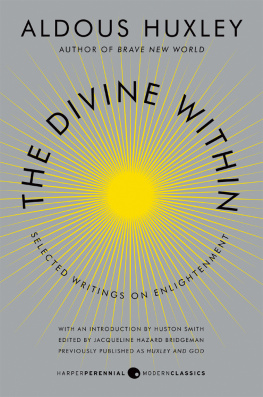The Doors of Perception
Aldous Huxley
If the doors of perception were cleansed everything would appear to man as it is, infinite. WILLIAM BLAKE
It was in 1886 that the German pharmacologist, Ludwig Lewin, published the first systematic study of the cactus, to which his own name was subsequently given. Anhalonium Lewinii was new to science. To primitive religion and the Indians of Mexico and the American Southwest it was a friend of immemorially long standing. Indeed, it was much more than a friend. In the words of one of the early Spanish visitors to the New World, they eat a root which they call Peyotl, and which they venerate as though it were a deity.
Why they should have venerated it as a deity became apparent when such eminent psychologists as Jaensch, Havelock Ellis and Weir Mitchell began their experiments with mescalin, the active principle of peyotl. True, they stopped short at a point well this side of idolatry; but all concurred in assigning to mescalin a position among drugs of unique distinction. Administered in suitable doses, it changes the quality of consciousness more profoundly and yet is less toxic than any other substance in the pharmacologists repertory.
Mescalin research has been going on sporadically ever since the days of Lewin and Havelock Ellis. Chemists have not merely isolated the alkaloid; they have learned how to synthesize it, so that the supply no longer depends on the sparse and intermittent crop of a desert cactus. Alienists have dosed themselves with mescalin in the hope thereby of coming to a better, a firsthand understanding of their patients mental processes. Working unfortunately upon too few subjects within too narrow a range of circumstances, psychologists have observed and catalogued some of the drugs more striking effects. Neurologists and physiologists have found out something about the mechanism of its action upon the central nervous system. And at least one professional philosopher has taken mescalin for the light it may throw on such ancient unsolved riddles as the place of mind in nature and the relationship between brain and consciousness.
There matters rested until, two or three years ago, a new and perhaps highly significant fact was observed. Actually the fact had been staring everyone in the face for several decades; but nobody, as it happened, had noticed it until a young English psychiatrist, at present working in Canada, was struck by the close similarity, in chemical composition, between mescalin and adrenalin. Further research revealed that lysergic acid, an extremely potent hallucinogen derived from ergot, has a structural biochemical relationship to the others. Then came the discovery that adrenochrome, which is a product of the decomposition of adrenalin, can produce many of the symptoms observed in mescalin intoxication. But adrenochrome probably occurs spontaneously in the human body. In other words, each one of us may be capable of manufacturing a chemical, minute doses of which are known to cause profound changes in consciousness. Certain of these changes are similar to those which occur in that most characteristic plague of the twentieth century, schizophrenia. Is the mental disorder due to a chemical disorder? And is the chemical disorder due, in its turn, to psychological distresses affecting the adrenals? It would be rash and premature to affirm it. The most we can say is that some kind of a prima facie case has been made out. Meanwhile the clue is being systematically followed, the sleuthsbiochemists, psychiatrists, psychologistsare on the trail.
By a series of, for me, extremely fortunate circumstances I found myself, in the spring of 1953, squarely athwart that trail. One of the sleuths had come on business to California. In spite of seventy years of mescalin research, the psychological material at his disposal was still absurdly inadequate, and he was anxious to add to it. I was on the spot and willing, indeed eager, to be a guineapig. Thus it came about that, one bright May morning, I swallowed fourtenths of a gramme of mescalin dissolved in half a glass of water and sat down to wait for the results.
We live together, we act on, and react to, one another; but always and in all circumstances we are by ourselves. The martyrs go hand in hand into the arena; they are crucified alone. Embraced, the lovers desperately try to fuse their insulated ecstasies into a single selftranscendence; in vain. By its very nature every embodied spirit is doomed to suffer and enjoy in solitude. Sensations, feelings, insights, fanciesall these are private and, except through symbols and at second hand, incommunicable. We can pool information about experiences, but never the experiences themselves. From family to nation, every human group is a society of island universes.
Most island universes are sufficiently like one another to permit of inferential understanding or even of mutual empathy or feeling into. Thus, remembering our own bereavements and humiliations, we can condole with others in analogous circumstances, can put ourselves (always, of course, in a slightly Pickwickian sense) in their places. But in certain cases communication between universes is incomplete or even nonexistent. The mind is its own place, and the places inhabited by the insane and the exceptionally gifted are so different from the places where ordinary men and women live, that there is little or no common ground of memory to serve as a basis for understanding or fellow feeling. Words are uttered, but fail to enlighten. The things and events to which the symbols refer belong to mutually exclusive realms of experience.
To see ourselves as others see us is a most salutary gift. Hardly less important is the capacity to see others as they see themselves. But what if these others belong to a different species and inhabit a radically alien universe? For example, how can the sane get to know what it actually feels like to be mad? Or, short of being born again as a visionary, a medium or a musical genius, how can we ever visit the worlds which, to Blake, to Swedenborg, to Johann Sebastian Bach, were home? And how can a man at the extreme limits of ectomorphy and cerebrotonia ever put himself in the place of one at the limits of endomorphy and viscerotonia or, except within certain circumscribed areas, share the feelings of one who stands at the limits of mesomorphy and somatotonia? To the unmitigated behaviourist such questions, I suppose, are meaningless. But for those who theoretically believe what in practice they know to be truenamely, that there is an inside to experience as well as an outsidethe problems posed are real problems, all the more grave for being, some completely insoluble, some soluble only in exceptional circumstances and by methods not available to everyone. Thus, it seems virtually certain that I shall never know what it feels like to be Sir John Falstaff or Joe Louis. On the other hand, it had always seemed to me possible that, through hypnosis, for example, or autohypnosis, by means of systematic meditation, or else by taking the appropriate drug, I might so change my ordinary mode of consciousness as to be able to know, from the inside, what the visionary, the medium, even the mystic were talking about.
From what I had read of the mescalin experience I was convinced in advance that the drug would admit me, at least for a few hours, into the kind of inner world described by Blake and . But what I had expected did not happen. I had expected to lie with my eyes shut, looking at visions of manycoloured geometries, of animated architectures, rich with gems and fabulously lovely, of landscapes with heroic figures, of symbolic dramas trembling perpetually on the verge of the ultimate revelation. But I had not reckoned, it was evident, with the idiosyncrasies of my mental makeup, the facts of my temperament, training and habits.



